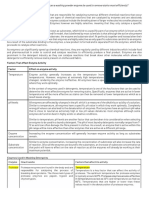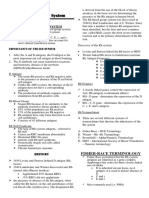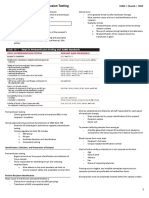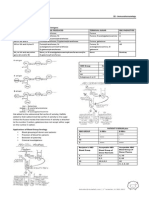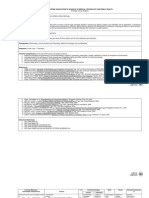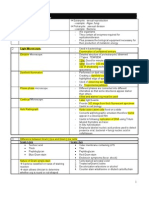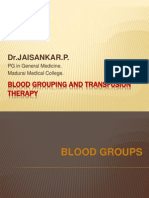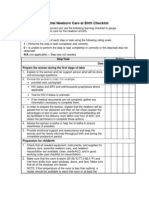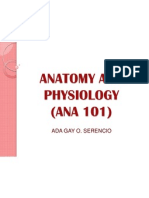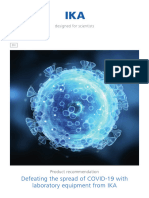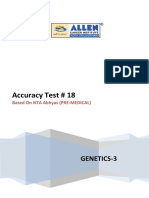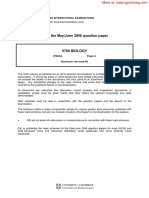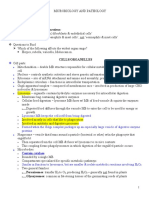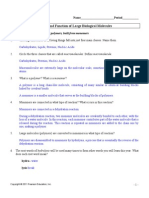Blood Banking
Blood Banking
Uploaded by
adagayCopyright:
Available Formats
Blood Banking
Blood Banking
Uploaded by
adagayOriginal Description:
Copyright
Available Formats
Share this document
Did you find this document useful?
Is this content inappropriate?
Copyright:
Available Formats
Blood Banking
Blood Banking
Uploaded by
adagayCopyright:
Available Formats
MOLECULAR GENETICS Gene- basic unit of heredity Genome- gene found in the long stretch of DNA Chromosome- super
compacted; part of DNA Chromatid- half of the chromosome Chromatin- loose enough to give nucleus protection Nucleosome- makes up a phromatin Allele- bondings in the chromosome Locus- specific side where allele is located DNA Replication, Repair, Mutations Double Helix Cytosine, Guanine, Adenine, Thymine DNA RNA Transcription, Translation Single Helix Cytosine, Guanine, Adenine, Uracil DNA Response to damage: 1. Cell Cycle Checkpoint activation 2. Transcriptional Program Activation 3. DNA Repair 4. Apoptosis Direct reversal Base excision repair Nucleotide excision repair Mismatch repair Double strand break repair Homologous recombination DNA MUTATION - Any change in the structure or sequence of DNA a. Physical b. Biochemical - Mutant vs. Wild type TYPES OF MUTATIONS 1. Base substitution a. Transition- pyrimidine to pyrimidine - purine to purine CUT the Py (Cytosine, Uracil, Thymine) Pure As Gold (Purine= Adenine, Guanine) b. Transversion- pyrimidine to purine (vise versa) Silent substitution- no change in amino acid Nonsense substitution- transforms to a stop codon Missence- complete change of amino acid 2. Deletion 3. Insertion RNA Single strand Uracil instead of thymine Transmit genetic info from nucleus to cytoplasm Types: rRNA, mRNA, tRNA RNA transcription o Initiation o Elongation o Termination RNA processing o Guanine cap is added o Removal of intron o Addition of mRNA Poly A - Extron- expressed - Intron- interferring RNA translation
- backbone of heredity - Double Helix - H-bond, phosphodiester bonds
DNA REPLICATION DNA gyrase- relaxes the supercoil DNA helicase- separates helixes (uncoil) RNA primase DNA polymerase III- elongates new strand Sliding clamp- so that it will not dislodge Single-stranded binding proteins- make sure DNA helixes does not recoil DNA polymerase I- removes primer DNA ligas- connects the fragment FRAGMENT OF DNA Replication fork Leading Strand Lagging Strand Okazaki fragment Causes of DNA damage: 1. Cellular Metabolism Vit B6- conversion of deoxyuridyl monophosphate and deoxy thymidyl triphosphate Vit B9- important in production of thymine Vit B12- necessary for absorption of B9 - conversion of folic acid into usable form 2. UV light exposure 3. Ionizing Radiation 4. Chemical Exposure 5. Replication Errors
IMMUNOLOGY - Ag- Ab reactions - studied because lab tests requires Ag- Ab reactions ABO grouping, Rh typing, Ab screening & identification, crossmatching - how to know Ag-Ab reaction occurs Quality control, trouble shooting, maintenance IMMUNE RESPONSE- physiological mechanism to fight disease or clear foreign substance PRIMARY IMMUNE RESPONSE - Slow reaction - First exposure to foreign object - IgM is the predominant Ab SECONDARY IMMUNE RESPONSE - Rapid reaction - Subsequent exposure of the same Ag - IgG predominant Ag CHARACTERISTICS Antigen- foreign substance Antigenecity- Ability of react to Abs Epitopes- Antigenic determinants
IMMUNE Ab - Produced when there is something foreign via transfusion, pregnancy, injection - Not found in nature - Mostly IgG, reacts at 37 degrees - Requires aid of AHG (Anti Humaglobulin) for manifestation of Ag-Ab reactions - AHG used for the visibility of rxn ALLO- ANTIBODIES- produced after exposure to genetically different Ag of the same species AUTO-ANTIBODIES- produced in response to self antigens INDICATORS OF Ag-Ab RXN 1. Sensitization-
Ab CHARACTERISTICS IgM Cold Agglutinin (4-10 deg) Cannot cross placenta Good complement activator
IgG 37 degrees Can cross placenta Poor complement activator Can activate comp but cannot finish rxn Stops at C3 Clinically significant
KULANG. INSERT WRITTEN NOTES. AND OTHER BLOOD GROUPS INFO ASIDE FROM ABO.
Usually not clinically sig. Because they are cold agglutinins aside from ABO group w/ Y thermal reactivity Significant if it can cause HDN & transfusion rxn ABO, Ii, Lewis, MN & P
Rh, Kell, Kidd, Duffy & Ss
IgA- found in secretions, dimer
NATURALLY OCCURING - found in serum of an individual not exposed to Ag via transfusion, injection, pregnancy - Produced in response to substances in environment - Most are IgM cold agglutinins, activates complement
RED BLOOD CELL SUBSTITUES Why are there Red blood cell substitutes? 1. Rare blood types 2 Multiple transfusions Hemoglobin-based oxygen carriers a.) Acellular b.) Cellular Perfluorocarbon Hemoglobin-based oxygen carriers 1. HbOC (Stroma free Hb solution) 2. HbOC (Chemically modified Hb Solution) Polymerized Hb Surfaced modified Hb 3. HbOC (Recombinant Hb) 4. HbOC (Encapsulated Hb) Perfluorocarbons- all hydrogen atoms are replaced with fluorine Platelet Preservation Platelet is vital in primary hemostasis a. cytoplasmic fragment b. has no nucleus c. circulating lifespan of 9-12 days d. Normal values: 150-350 x 10^9/L e. biggest mature blood cell CLINICAL USE: Treat Bleeding, As a prophylaxis PREPARATION: Whole blood transfusion Plate rich plasma Platelet concentration Platelet-rich plasma method Buffy coat method Why does it have to be kept in room temperature until platelets are harvested? Storage preservation: 20-24C with constant agitation Kept for 5 days BLOOD REPLACEMENT FLUIDS Intravenous Fluid A. Maintenance fluid: unavailable oral route Replace normal physiological losses Volume dispersion All are crystalloid solutions Example: 5% dextrose, 4% dextrose, 0.18% NaCl
B. Replacement fluid: abnormal losses treatment of patient with ongoing fluid loss treatment of patient with hypovolemia Example: NSS, Hartmanns solution LECTINS and PROLECTINS Lectins: specific antibodies derived from plants Prolectins: specific antibodies derived from snails Lectin Anti-A Anti-B Anti-H Prolectins Anti-A Anti-A1 Anti-B Anti-H Source Helix pomatia Helix aspersa Euphrada periomphala Bradybaena fructicum Salmo irideus Anguilla anguilla Source: Dolichos biflorus Bandeiraea simplicifolia Fomes fomentarium Ulex auropaeus
Genetics: Mendel Law of Segregation How genes are passed from one generation to another Incomplete dominance Law of independent assortment Describes the independent segregation of alleles of different loci Genes of different trait are inherited separately from each other Inheritance patterns: Pedigree analysis Autosomal recessive Autosomal dominance X-linked recessive X-linked dominant Cellular genetics Mitosis: divide to create identical daughter cells Meiosis: produce gametes, 4 unique daughter cells Many haploid number of chromosomes
Cell Cylce: 4 distinct stages If cells no longer need to divide they remain in G( 0 ) stage Not true to cancer cells Molecular Genetics: Gene: Genome: Chromosome: Chromatid: Chromatin: Nucleosomes: Allele: Locus: DNA (CGAT) Replication Repair Mutations RNA (CGAU) Transcription Translation DNA Backbone of heredity Double Helix H-bonds, phosphodiester Nitrogenous bases Histone; Nucleosome DNA Replication DNA gyrase DNA helix RNA primase DNA polymerase III Sliding clamp Single stranded binding Proteins DNA polymerase I DNA ligase DNA REPLICATION Replication fork Leading strand Lagging strand Okazaki fragment DNA DAMAGE Cellular damage UV light exposure Ionizing radiation Chemical exposure Replication errors
DNA REPAIR Cell cycle checkpoint activation Transcriptional program activation DNA repair system Direct reversal Base Excision Repair Nucleotide excision repair Mismatch repair Double strand break repair Homologous recombination Apoptosis DNA mutation Any change in the structure or sequence of DNA may it be physical or biochemical Mutant vs. Wild type Types of mutation Base Substitution Deletion Insertion RNA Single stranded Ribose sugar Uracil instead of thymine Types: rRNA, mRNA, tRNA Used to transmit genetic information RNA transcription (RNA Polymerase) RNA processing RNA translation
IMMUNOLOGY (Ag- Ab REACTION) What lab tests require Ag-Ab reaction? ABO grouping, Rh typing, screening and identifying, crossmatching Why do we need to know how Ag-Ab reactions occur? Quality control, trouble shooting, mainteanance Immune response: Physiological mechanism to fight disease or clearing of foreign substances A. Primary Response First exposure of a foreign agent IgM is the predominant antibody B. Secondary Response (amenestic) Faster response Subsequent exposure of the same foreign agent IgG Ag Characteristics Antigen- something foreign Antigenicity- ability to react to antibodies Epitopes- antigenic determinants IgM- Most common, found in blood, pentamer, cold (4-10), cannot cross placenta, good complement activators, usually not clinically significant. ABO, Ii, Lewis, MN and P IgG- Monomer, works best at 37 degrees, can cross placenta, poor to good complement activators, usually clinically significant. Rh, Kell, Kidd, Duffy and Ss Naturally occurring Found in the serum of individuals who have been exposed to antigens through transfusion, injection or pregnancy May be produced in response to substances in environment Most are IgM cold agglutinins, activates complements and hemolytic at 37 Immune Antibody Found in the serum of individuals who have been transfused or pregnant IgG Not found naturally Requires the aid of Anti-Human globulin Note: Clinically significant IgGs can cause Hemolytic disease of new born or Transfusion reactions IgM is not clinically significant because they only react in cold temperature Cold reacting Antibody with wide thermal reactivity Allo-antibody and auto-antibodies Allo-antibodies are produces after exposure to genetically different non-self, antigens of the same species. Auto-antibodies are produces in response to self-antigens. Indicators of Antigen and Antibody reactions 1. Sensitization Ab coating RBC without agglutination Requires AMG for visualization 2. RBC lysis (hemolysis) Immune mediated complementary activation completion Supernatant is clean and red
3. Agglutination Antibody mediated clumping of Red blood cell AHG - Used to visualize reaction in DAT and IAT - AHG can be monoclonal or polyclonal Agglutination Reaction 1. Sensitization (Stage 1) Attachment of Ag and Antibody of red blood membrane Electrostatic forces, H bonds, Hydrophilic forces and Van Der Waals forces 2. Lattice Formation (Stage 2) Formation of lattice between sensitized red cells Factors affecting Stage 1 of Agglutination A. Temperature Cold (4-10C)- ABO, P1, Lewis Ab - Carbohydrate natures of ABO Ag Warm (37C)- Rh antibodies, Protein nature of Rh Ag B. pH- Changes in pH can affect electrostatic bonds - Optimal range in physiological pH (6.50-7.5) C. Incubation time- Time needed to reach equilibrium - Saline systems: 30-60 minutes at 37C - LISS (Low Ionic Strength Solution) D. Ionic Strength NSS- Na and Cl ions partially opposite charges on Ag and Ab molecule LSS- Increase rate of Ag-Ab association - Decreases incubation time - Concentration of Ag and Ab affects with the first as severed stages. Factors affecting stages of Agglutination A. Size of Ig IgG: monomer, takes 2 to activate complement IgM: pentamer, takes one to activate complement B. Number of binding sites of Ig IgG: 2 binding sites (Anti-D, Anti-JKa, etc.) IgM: 10 binding sites (Anti-A, and B) C. Location and number of Antigenic deteminants A,B,M and N antigens: 600,000-1,000,000 Ag/RBC Kidd: 10-20,000 Ag/RBC D. Centrifugation Bringing Ab and Ag into close proximity Under centrifugation: false (-) Over centrifugation: false (+) Zeta potential: net negative charge surrounding RBC Water of Hydration: acts as an insulating bubble around RBC RBC DISTANCE: In the body RBCs should be distant Water of hydration Electrostatic charges In the lab or in vitro, we need to overcome these forces to observe Ag and Ab reactions REACTION MEDIA: 22% Albumin Decreases zeta potential by buffering Allows Ab- coated cells to come closer-together Polyethanol glycol Removes H2O, concentrating Hb
ABO BLOOD GROUP History: Karl Landsteiner- first to perform forward and backward typing Genes: ABO gene at C9 and H and SE genes at C19 Single most important blood group for the selection and transfusion of blood Widely expressed-> tissues and blood fluids Inheritance of ABO blood group system Example of determining offspring blood types from known or suspected genotypes A AA AB Frequency Caucasian 45% 41% 10% 4% Asian 47% 26% 23% 4% O AO BO
Produced due to the interaction A,B,H,Se, genes Genes code for glycosyltransferases with attached sugar to precursor material (paragloboside) Genes do not produce Ag genes, genes produce enzymes to express the antigens
Paragloboside 4 Sugars (2 D-galactose, 1 glucose, 1 N-acetylglucosamine) 2 types Type 1: precursor in the secretion (1-3 linkage) Type 2: precursor in Red blood cell (1-4 linkage) Three precursor substance to which the L-fucose is attached to produce an H antigen Formation of Antigens in Red Blood Cells H antigen Possible genotypes HH, Hh, or hh HH/Hh (+) -> alpha-2-L-fucosyl transferase-> responsible for the attachment of L-fucose to paragloboside hh-> amorph gene (does not produce enzyme) group has RBC rich in H ag O>A2>B>A2B>A1>A1B H Antigen The immunodominant sugar is L-fucose Linear (2) H1 and H2 Branched (2) H3 and H4 Formation of Antigen in Red blood cells ABO Antigen Inherited in simple Mendelian fashion from an individuals parents 3 possible genes can be inherited= A, B,O A and B genes-> detectable product/enzyme genes-> no product Present on the surface of RBCs, tissues and endothelial cells A antigen- the immunodominant sugar is N-acetyl-Dgalactosamine B antigen- the immunodominant sugar is Dgalactosamine
A B Blood Group O A B AB
Made up of: Antigens expressed in the Red cells Absence of its corresponding Ab in serum Four genes: A,B,H,Se Three Antigens: A,B,H Two major antibodies: anti A and anti B, Anti H Four Phenotypes: A, B,AB, O ABO antibodies Initiated at birth but very low titers Complete absence is very rare Antibodies in A and B groups -> IgM Antibodies in O group -> IgG React at 20-24C Activates complement at 37C Anti H:
Naturally occurring autoantibodies IgM in form; low thermal range A1 and A1B individuals Seldom clinically significant Occurs as allo-antibodies (IgG and IgM) among O(subscript) h -> Bombay
Gene
Glycosyltransferase
Immunodominant sugar L-fucose N-acetyl-Dgalacotasamine
Antigen
ABO antigen th nd Begins at the 37 day of fetal life (2 month accdg to Henry) Final strength at age (2-4) (1 y.o accdg to Henry) Persistent throughout life Found in saliva, pancreatic secretions, gastric secretions (secretor) May be found in bacteria and other species Formation of AB and H antigens
H A
L-fucosyl transferase N-acetyl galactosaminyl transferase D-galactosyl
H A
D-galactose
Blood group Diego 1955 a Ab 1967 b Ab 1995 Wr Cartwright 1956 Xg 1962
Chr 17
High Freq Ag b b Di , Wr
HF Phenotype Di (a-b+) Wr (a-b+)
OTHER BLOOD GROUPS Ag Characteristics Ab Characteristics a b b Di and Di - polymorphic Anti Di cause HDN and HTR IAT Reactive Do not bind comp Yt = adult, strong Ag, neg cord bld b Yt well developed at birth, poor Ag Homology with CD99 in RC
a
Antigen Location, Linkage, Disease AE-1 Hereditary spherocytosis Congenital acanthocytosis Ag- located on erythrocyte Acethyl Cholinesterase (AChE) Cell to cell adhesion events
7 X
Yt
Yt (a+b-) Xg (+)
Yt IgG, IAT reactive Bind C variably IgG sensitive to: B, Ficin Not affected with DDT 1 2 Sc Sc IgG IAT reactive and bind C 1 Sc no HDN 2 Sc mild HDN 3 Sc linked to HTR React best as AHG a Do - mild HDN Combine with other Abs IAT with PEG acute delayed HTR IgG, IAT reactive, bind C HTR and no HDN Erythrocyte band 41
Xg
Scianna 1962
Sc
Sc
Sc (1+2+)
Resistant: P, F, T, chy T Sensitive to DDT Expressed on RBCs of newborns
Dombrock 1965 Gregory G4 Holley Hy Joseph Jo Colton 1967
12
Do
Do
Do (a+b+)
Co
Co (a+b-)
Resistant: Ficin Papain Weakend chyT Sensitive: T and DTT a b Do and Do - poor immunogens a Gy immunogenic Resistant: Protease, sialidase, DTT and acid
Carried on mono ADP ribosyl transferase (ART4)
Chido 1967 Roders 1976
Ch Ch 1 2 Rg Rg
Ch (1+2+)
Poorly expressed on cord Absorbed into RC from plasma Affected by Ficin and Papain Ge2 sensitive: F P T Ge3 sensitive: F P Resistant: DTT and chyT Resistant: F P Weakend: DTT Sensitive: chyT Poorly expressed on cord cells Decreased during pregnancy Poorly expressed on cord cells Decreased in patient with AIDS Weakened by F and P Sensitive to T and chyT Resistant to DTT
HTLA Weakly react at IAT (IgG4)
Gerbich 1960
Ge
2 3 4
Ge (2+ 3+ 4+)
Cromer 1965
Cr
Cr (a+b-)
IgG, bind C Red cell stimulated Casue delayed HTR and no HDN IgG, IAT reactive Red cell stimulated No HDN
Co (a-b-) associated w/ dyserythropoietic anemia Located on transport CHON CHIP (Channel Forming Integral Protein) Primary RBC water channel and responsible for H2O permeability a Rg linked to C4 b Ch linked to C4 Null Ch due to C4 deletion Psoriasis, Graves disease, SLE, RA Leach null Ge
Carried by DAF (CD55) a Dr , E. coli receptor (uropathogenic)
Knops McCoy York 1991
Kn
Kn (a+b-)
IgG, IAT reactive Decreased activity with T and chyT No HDN, HTR
Reside with CR1 (CD35) P. falciparum Decreased Kn Ags in Lu (a-b-) w/ in Lu genes
Indian 1973
11
In
In a(-b+)
Ok 1979
19
Ok
Ok (a+)
Poorly expressed on cord Decreased during pregnancy Decreased in Lu (a-b-) with In Lu R: Protease, sialidase, DTT Well developed at birth
IgG, IAT Red cell stimulated b In associated w/ HTR and no HDN IgG, IAT reactive
Carried by hematopoietic form CD44
Raph 1990
11
RAPH
Bennet Godspeed LW 1990
Bg
Bg (a+b-)
19
LW
LW (a+b+)
Resist: F P Sialidase Sensitive: T chyT and DTT RBC of newborns M- monoclonal ER- Eleanor Rosevelt Associated: a b HLA B7 Bg HLA B17-Bg HLA c A28- Bg Resist: F P T chyT Sialidase Sensitive: Pronase and DTT
IgG, IAT reactive, Bind C
CD 147- hematopoietic- BB barrier CD147 in human on tumor cellstimulated release collagenase and metalloproteinases enhance tumor cell invasion and metastasis Expressed in fibroblasts MER2, decreased in Lu (a-b-) w/ in Lu If decreased MER2= renal failure
Destroyed by chloroquine, glycineHCl EDTA solution No HTR and HDN IgM-IgG Occur in dTR and mHDN
Associated w/ IM, Leukemia, PCV and HA Loss of LW- production of anti LW associated w/ leukemia, lymphoma, sarcoma, Hodgkins dse ICAM binds to CD11/ CD18 leukocyte integrins
You might also like
- Laundry Detergent Enzyme Deconstruct and DesignDocument4 pagesLaundry Detergent Enzyme Deconstruct and DesignAndrew ThomasNo ratings yet
- ASCP Review Course: Review Questions: Blood Banking and Transfusion MedicineDocument18 pagesASCP Review Course: Review Questions: Blood Banking and Transfusion MedicineMarl Estrada100% (1)
- BB NotesDocument15 pagesBB NotesThea Gonzales100% (4)
- Reviewer - Immmunohematology - Part 2Document29 pagesReviewer - Immmunohematology - Part 2Joshua TrinidadNo ratings yet
- Reviewer - Immunohematology - Part 1Document16 pagesReviewer - Immunohematology - Part 1Joshua TrinidadNo ratings yet
- Blood Bank 2Document21 pagesBlood Bank 2moonfire2009No ratings yet
- Pre Transfusion TestingDocument67 pagesPre Transfusion TestingPaulino GarciaNo ratings yet
- Blood Bank Harmening Chapter 10Document14 pagesBlood Bank Harmening Chapter 10ichummy19100% (3)
- Modern Blood Banking & Transfusion Practices Ed6 Harmening-235-257Document23 pagesModern Blood Banking & Transfusion Practices Ed6 Harmening-235-257ivanlchNo ratings yet
- Detection of AntibodiesDocument7 pagesDetection of AntibodiesJezreeljeanne Largo Caparoso100% (1)
- IMH100 2nd Handout - Immunology Part II and ABO Blood GroupDocument4 pagesIMH100 2nd Handout - Immunology Part II and ABO Blood GroupnicholeNo ratings yet
- Blood Banking ReviewDocument442 pagesBlood Banking ReviewMayra Flor100% (3)
- Blood Bank Case StudyDocument17 pagesBlood Bank Case StudyMelissa Harding25% (4)
- Drug StudyDocument17 pagesDrug StudyadagayNo ratings yet
- Other Blood Group Minor Antigen (Other Than The D (RH), CC, Ee, Etc) SystemsDocument51 pagesOther Blood Group Minor Antigen (Other Than The D (RH), CC, Ee, Etc) Systemssbabu_254849No ratings yet
- Other Blood Group System AssignmentDocument5 pagesOther Blood Group System AssignmentMary Christelle100% (1)
- Blood BankingDocument9 pagesBlood BankingKimverlyn Balanay AgpaloNo ratings yet
- Immunohematology NotesDocument1 pageImmunohematology NotesAlyanna BaldoquinNo ratings yet
- RH BLOOD GROUPDocument23 pagesRH BLOOD GROUPWho KnowsNo ratings yet
- HOWARD REVIEW QUESTIONS 1-4 Blood Banking and Transfusion Practices, 3EDocument10 pagesHOWARD REVIEW QUESTIONS 1-4 Blood Banking and Transfusion Practices, 3EIvory Mae Verona Andaya100% (1)
- Immunohematology Handouts UpdatedDocument15 pagesImmunohematology Handouts UpdateddmclmllNo ratings yet
- Blood BankingDocument7 pagesBlood BankingRoiland Atienza BaybayonNo ratings yet
- Antibody IdentificationDocument74 pagesAntibody IdentificationNilver Zenteno100% (4)
- 22 - ImmunohematologyDocument6 pages22 - Immunohematologyhamadadodo7No ratings yet
- Blood Banking - Component PreparationDocument34 pagesBlood Banking - Component PreparationLentoOt EksDiiNo ratings yet
- Cross MatchingDocument2 pagesCross MatchingHimanshu_0No ratings yet
- Immunohema QuestionDocument19 pagesImmunohema QuestionLily Beauty100% (1)
- Blood Bank TypingDocument34 pagesBlood Bank TypingSkylarNo ratings yet
- Blood Bank 3Document20 pagesBlood Bank 3moonfire2009100% (2)
- Adverse Reaction Blood BankDocument10 pagesAdverse Reaction Blood BankyourfamilydoctorNo ratings yet
- ABO Discrepancy Assignment Spring 2021Document5 pagesABO Discrepancy Assignment Spring 2021Ciarra Asuncion100% (2)
- Gel Card TechnologyDocument21 pagesGel Card TechnologyDominic BernardoNo ratings yet
- MUST To KNOW in Immunohematology Blood BankingDocument18 pagesMUST To KNOW in Immunohematology Blood BankingDanielJeremy DelaCruz Paragas79% (14)
- Coombs Test FreddyDocument11 pagesCoombs Test FreddyFreddy Vallejo LeonNo ratings yet
- Blood Bank Guy Blood GroupsDocument19 pagesBlood Bank Guy Blood GroupsJessica TuNo ratings yet
- Immunohematology/ Blood BankingDocument2 pagesImmunohematology/ Blood BankingSophia AmpatuanNo ratings yet
- Group 6 - Immunohematology - Blood BankingDocument8 pagesGroup 6 - Immunohematology - Blood Bankingjulo_05No ratings yet
- Blood BankDocument84 pagesBlood Bankmanni1001100% (4)
- Pre Transfusion TestingDocument57 pagesPre Transfusion TestingDominic Bernardo100% (4)
- Blood Bank ProceduresDocument33 pagesBlood Bank Procedures99noname100% (1)
- Blood BankDocument32 pagesBlood Bankpikachu100% (1)
- ABO DiscrepanciesDocument40 pagesABO DiscrepanciesAlondra Sagario100% (2)
- Blood Bank 4 DiscpDocument20 pagesBlood Bank 4 DiscpHector de la Cruz100% (1)
- Clinical Chemistry 1 Notes NPNDocument4 pagesClinical Chemistry 1 Notes NPNDavid HosamNo ratings yet
- Immunohematology and Blood Banking Techniques Class NotesDocument172 pagesImmunohematology and Blood Banking Techniques Class NotesManoj Kumar Patro67% (3)
- Characteristics of Blood Group Antibodies: Immunoglobulin Class Remarks Associated With Antigen Frequency (%)Document1 pageCharacteristics of Blood Group Antibodies: Immunoglobulin Class Remarks Associated With Antigen Frequency (%)yepNo ratings yet
- University of Santo Tomas Immunohematology and Transfusion MedicineDocument7 pagesUniversity of Santo Tomas Immunohematology and Transfusion MedicineWynlor Abarca100% (1)
- Blood Bank QuizDocument13 pagesBlood Bank Quizdimalawang.af100% (1)
- Immunohematology Review ASCLSGA 2015 PDFDocument49 pagesImmunohematology Review ASCLSGA 2015 PDFSheanalene CastroNo ratings yet
- Blood Group Systems ISBTDocument25 pagesBlood Group Systems ISBTkusumahpratiwi100% (1)
- Blood Component PreparationDocument24 pagesBlood Component PreparationLaiba Arshad100% (1)
- Coombs TestDocument15 pagesCoombs TestFatema AminNo ratings yet
- 13 Other Blood Group SystemsDocument56 pages13 Other Blood Group SystemsCarinaJongLeeNo ratings yet
- ML7111 MCQs Answers Sep 2019Document10 pagesML7111 MCQs Answers Sep 2019Cleo Salvador100% (2)
- Compatibility TestingDocument70 pagesCompatibility TestingHazel100% (2)
- Immunology & Serology: Preliminaries: Romie Solacito, MLS3CDocument12 pagesImmunology & Serology: Preliminaries: Romie Solacito, MLS3CRomie Solacito100% (2)
- Microbiology ReviewDocument38 pagesMicrobiology Reviewsyringomyelia100% (5)
- Blood Groups (BB)Document36 pagesBlood Groups (BB)Khalid SeliaNo ratings yet
- Blood Bank VDocument78 pagesBlood Bank VPerlie CNo ratings yet
- DR - Jaisankar.P.: Blood Grouping and Transfusion TherapyDocument63 pagesDR - Jaisankar.P.: Blood Grouping and Transfusion TherapyDrSanjeev ShrivastavaNo ratings yet
- Anatomy Practice Questions (PN)Document3 pagesAnatomy Practice Questions (PN)adagayNo ratings yet
- A Poem Written by DRDocument1 pageA Poem Written by DRadagayNo ratings yet
- ENC - at Birth Checklist - Uganda MNCH Facility CollaborativeDocument5 pagesENC - at Birth Checklist - Uganda MNCH Facility CollaborativeadagayNo ratings yet
- Anatomy and Physiology (ANA 101) : Ada Gay O. SerencioDocument7 pagesAnatomy and Physiology (ANA 101) : Ada Gay O. SerencioadagayNo ratings yet
- Antiulcer DrugsDocument3 pagesAntiulcer DrugsadagayNo ratings yet
- Topic 8 PDFDocument38 pagesTopic 8 PDFSiyabonga NkosiNo ratings yet
- Energy Rich CompoundDocument14 pagesEnergy Rich CompoundSaurav singh SikarwarNo ratings yet
- Compare and Contrast Neostigmine and The Organophosphate CompoundsDocument1 pageCompare and Contrast Neostigmine and The Organophosphate CompoundsDonkeyManNo ratings yet
- Balanced Nutrition For Different Phases of Chicken: Nutrition and Nutrient ManagementDocument12 pagesBalanced Nutrition For Different Phases of Chicken: Nutrition and Nutrient Managementamamùra maamarNo ratings yet
- Defeating The Spread of COVID 19 With Laboratory Equipment enDocument8 pagesDefeating The Spread of COVID 19 With Laboratory Equipment enamor kermayaNo ratings yet
- Evolution Tinker: ScienceDocument7 pagesEvolution Tinker: SciencePhilippe Miotto Dos SantosNo ratings yet
- (Test 18) Nta Genetics 3Document7 pages(Test 18) Nta Genetics 3Abhishek KumarNo ratings yet
- Fisiologi Traktus DigestivusDocument39 pagesFisiologi Traktus DigestivusdrhendyjuniorNo ratings yet
- Biology: I. Define Biology and Its BranchesDocument11 pagesBiology: I. Define Biology and Its Branchesanon_381785486No ratings yet
- BIOCHEM 1.01 BioenergeticsDocument3 pagesBIOCHEM 1.01 BioenergeticsPerlyn Mac Basiloy - AloNo ratings yet
- Biology Essay 2021Document3 pagesBiology Essay 2021imaadjeewaNo ratings yet
- BCH 214 Tutorial 2 2013 Memo & QuesDocument6 pagesBCH 214 Tutorial 2 2013 Memo & QuesvictorNo ratings yet
- MGI Library Prep Kits Updates - 20240822 - YiluDocument12 pagesMGI Library Prep Kits Updates - 20240822 - YilumouhNo ratings yet
- Leaf Structure Amc 1Document24 pagesLeaf Structure Amc 1myatlaykhinNo ratings yet
- 9700 s06 Ms 4 PDFDocument5 pages9700 s06 Ms 4 PDFIG UnionNo ratings yet
- MICROBIOLOGY & PATHOLOGY NuggetsDocument233 pagesMICROBIOLOGY & PATHOLOGY NuggetsFaraz SayedNo ratings yet
- IGCSE GRADE 10 SMA Pribadi Bandung 15 September 2020: Learning ObjectivesDocument28 pagesIGCSE GRADE 10 SMA Pribadi Bandung 15 September 2020: Learning ObjectivesawanbioscienceNo ratings yet
- Laboratory Manual DraftDocument97 pagesLaboratory Manual DraftMartin LeeNo ratings yet
- Dr. Jullyanny - LaboratoriumDocument21 pagesDr. Jullyanny - Laboratoriumyohanes gabriel dwirianto w.aNo ratings yet
- Membrane - FunctionDocument4 pagesMembrane - Functionphuong anhNo ratings yet
- 11 LS Viruses Part 1Document13 pages11 LS Viruses Part 1Adhi PandayNo ratings yet
- 2012 DSE Bio 1B Marking Scheme PDFDocument6 pages2012 DSE Bio 1B Marking Scheme PDFCassandra YanNo ratings yet
- 9700 BIOLOGY: MARK SCHEME For The October/November 2015 SeriesDocument12 pages9700 BIOLOGY: MARK SCHEME For The October/November 2015 SeriesNerminNo ratings yet
- Interaction Between Biomolecules and NanoparticlesDocument85 pagesInteraction Between Biomolecules and NanoparticlesshabanaNo ratings yet
- Chapter 5 BioDocument10 pagesChapter 5 Biozehn100% (4)
- Integration of MetabolismDocument44 pagesIntegration of MetabolismSyedaNaveenBatool100% (1)
- Biotechnology Principles & Processes Biohack Questions OnlyDocument4 pagesBiotechnology Principles & Processes Biohack Questions OnlyAtharva SchoolsNo ratings yet
- Biology Homework WorksheetsDocument12 pagesBiology Homework Worksheetsnush :DNo ratings yet
- Metabolisme Lysine 2Document26 pagesMetabolisme Lysine 2Denok Risky Ayu ParamitaNo ratings yet
